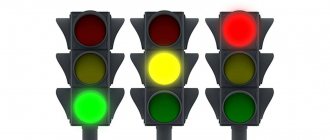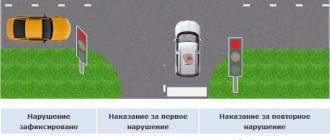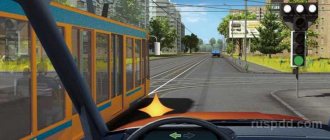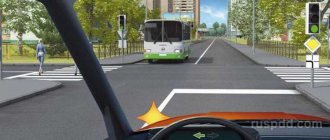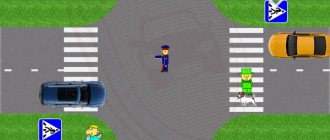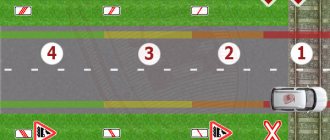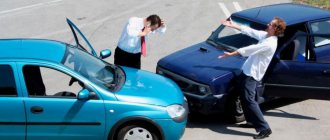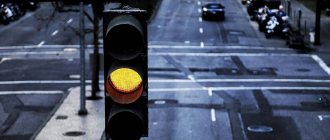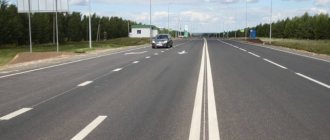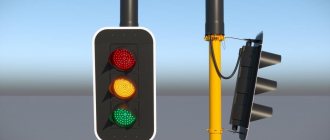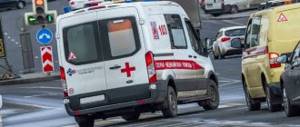Driving on roads must comply with traffic regulations. The rules are aimed at minimizing the risk of accidents and increasing the comfort of drivers and pedestrians. Failure to comply with the standards will result in a monetary penalty. To ensure that drivers stop in advance of traffic lights, stop lines are drawn. Crossing the stop line in violation of the rules in 2021 is punishable by a fine.
Fixing the crossing of a stop line in front of a traffic light is carried out automatically or by traffic police officers. The imposition of a monetary penalty in the form of a fine is carried out taking into account a number of features that you need to know about in advance.
The fine for crossing the stop line in front of a traffic light is 800 rubles (Part 2 of Article 12.12 of the Code of Administrative Offenses of the Russian Federation). Punishment is applied if a person stops at the stop line or further, when there is a prohibiting traffic light signal or a traffic controller’s gesture.
Attention! If you have any questions, you can chat for free with a lawyer at the bottom of the screen or call Moscow; Saint Petersburg; Free call for all of Russia.
What is a stop line?
Stop line is a road marking numbered 1.12, indicating the place where the driver is required to stop in the presence of a 2.5 (STOP) sign, a prohibitory signal from a traffic light or a traffic controller. Information about the line is given in paragraph 1.12 of Appendix 2 of the Traffic Regulations of the Russian Federation approved by Decree of the Government of the Russian Federation No. 1090 of October 23, 1993.
The need to draw a stop line in front of a traffic light and assign a fine for crossing in 2021 is due to the following reasons:
- encourage drivers to let pedestrians cross the zebra crossing;
- minimize the risk of accidents when performing maneuvers;
- protect the vehicle from collisions with cars moving perpendicularly.
If there is a traffic light and it is located above the roadway, the markings are applied at a distance of 10 - 20 m from it. When the device is placed on the side, the distance will be 3 – 5 meters. Compliance with parameters is carried out to ensure the visibility of signals.
If there is a pedestrian crossing, marking 1.12 (stop line) in 2021 is placed 1 m in front of it. When a traffic light is located in front of a railway crossing, a stop line will be drawn at a distance of 5 m. The above rules are regulated by GOST R 52289 - 2004.
Stopping at a stop line sign
The motorist must clearly understand where he should stop.
If there is a marking, you need to stop in front of it. Usually the line is located 3-5 meters before the traffic light.
If there is no horizontal line, the driver must act in accordance with the sign and take a break from driving immediately in front of it.
When using the sign and markings simultaneously, the stop is made in front of these signs. This situation does not cause difficulties when the sign and markings are placed on the same line, that is, they are installed in full accordance with the requirements of regulatory documents on standardization.
All this matters in relation to controlled intersections, that is, those where traffic is regulated:
- traffic light;
- traffic controller.
Neglecting the stop line is dangerous not only and not so much in financial losses, but in possible damage to health and even life.
When should you stop at the stop line in 2021?
The stop line and traffic light signals actually contradict each other. This causes confusion for car enthusiasts. The situation is regulated by clause 6.15 of the Russian Federation Traffic Regulations. It states that drivers and pedestrians are required to follow the requirements of traffic signals, even if they conflict with priority signs. In turn, part 1 of the Decree of the Government of the Russian Federation No. 1090 of October 23, 1993 stipulates that signs are more important than the horizontal marking line. From the above it follows that first of all you need to take into account traffic light signals. The situation changes when a traffic controller is present. Drivers are obliged to comply with its instructions, first of all, in accordance with paragraph 6.15 of the Russian Traffic Regulations.
In 2021, it is necessary to stop before the stop line if the traffic light is prohibiting, or the traffic controller shows a gesture that does not allow movement. The driver must wait for the green light or the permitting gesture of the traffic controller (clause 6.13 of the Russian Traffic Regulations). Otherwise, a fine will be imposed for crossing the stop line in front of a traffic light.
When the traffic light is green, traffic is allowed. There is no need to stop before the stop line. A similar rule applies if the traffic controller does not prohibit movement.
There are situations when the marking is supplemented with a STOP sign. In 2021, the following feature is important - when a stop line and a STOP sign on a white background are located at different distances from the intersection, you must stop in front of the sign.
A fine can be imposed not only for stopping incorrectly before the stop line, but also when starting to move. Driving on a yellow traffic light is prohibited, except in situations where drivers cannot stop without resorting to emergency braking at an intersection, in front of a railway crossing, traffic light or traffic controller (6.2 Traffic Regulations of the Russian Federation). The ban also applies to driving on red. Violation of the rule will entail a change in the amount of the fine for crossing the stop line in front of a traffic light.
Is a fine for yellow legal?
So, let's start with the fact that, according to the administrative legislation of 2021, any doubts about your guilt are interpreted in your favor. This means that if there is even the slightest doubt that you are guilty of violating traffic rules, then the decision must be canceled. And only when guilt is 100% proven does the fine become legal. This is what Article 1.5 of the Code of Administrative Offenses on the presumption of innocence dictates to us.
However, there is also a note that this does not work in the case of video or photo cameras recording violations. And the fine here is imposed on the owner of the car. However, the general principle of the law should generally work. And this is one of the main principles in “administration”.
Now let's return to our topic and pose the question as follows: will the auto-fixation camera be able to determine whether the driver had the opportunity to stop without emergency braking? If the installation cannot clearly answer this question when recording, then the general principle of the law is violated - any doubts about the guilt of a person are interpreted in his favor.
Why do we need all this? That's why!
Photo recording cameras cannot be set to yellow according to GOST!
In practice in 2021, it is not at all possible to operate automatic detection devices to detect such a violation as driving through a yellow signal. Precisely for the reason that there is a condition in the traffic rules when such movement is not prohibited - the impossibility of stopping without sharp braking. Can the camera detect this possibility? Almost none of them can.
However, let us support the above statement with the official interpretation. The same GOST R57144-2016, only in table No. 3 of paragraph 6.5 contains conditions for the possibility of recording various violations by means of automatic recording.
And here the following requirements are contained to ensure the “F3” event, which is the detection of passage through a prohibiting traffic light signal.
- One or more photographs must be provided showing the location of the vehicle up to the stop line, and the traffic signal must be visible in the image.
- Or, alternatively, photographs of the car during or after passing through an intersection, a pedestrian crossing (if a traffic light regulates it) or while passing a railway crossing after a barrier or traffic light and up to or after the nearest rail. And here it is also necessary to have a prohibiting traffic light signal in the frame.
However, the key here lies in the fact that in all of the above conditions, in order to be able to automatically record passage to a prohibiting signal, it is indicated that in the frame of photographic materials obtained by means of such registration, there must be a red light, and not a yellow one.
Thus, if a decision has been issued against you with a fine, and you are sure (or the photographic materials in the copy of the document show) that you drove through a yellow signal and not a red one, then you need to appeal the fine. And the basis can be stated approximately as follows:
In accordance with paragraph 6.5.1 of the State Standard GOST R57144-2016, “Technical means of automatic photo-video recording must ensure the recording of events (including administrative offenses) and the generation of materials in accordance with the requirements given in tables 1-3.”
In accordance with the designations of F3 event materials, a prohibiting (red) traffic light signal for a certain direction of movement should be recorded on photographic materials in such technical means.
Based on the foregoing, the correct conclusion should be drawn that technical means of automatic photo-video recording are not used to record violations of passage on a prohibitory yellow traffic light.
In addition, I was moving in accordance with paragraph 6.14 of the Traffic Rules, without being able to stop in accordance with the requirements of paragraph 6.13 at the yellow signal.
What if you can't see the traffic light in the photo?
As we indicated above, on photographic materials obtained while driving through an intersection, for example, at a yellow traffic light under the camera, the current signal should be visible at the time the violation was recorded. If this is not the case, then the camera does not operate in accordance with GOST, and this also entails the legal cancellation of the imposed fine.
Should there be one photo or two?
But this no longer matters much. The fact is that Gosstandart provides for one, two or more photographic materials. In general, as a rule, cameras shoot video material, there is simply no way to attach the video to you by mail on paper, and therefore they simply send individual frames from the recording as justification for the fine imposed.
Something else useful for you:
- Is it possible to order and legally drive without a fine with license plates without the Russian flag?
- What is the fine for parking and driving on the sidewalk? Appeal and subtleties of traffic rules
- Is it necessary to comply with reduced traffic signs?
What if the photo is not included in the materials at all?
This is also an insignificant drawback of the copy of the resolution you received. The fact is that, although GOST stipulates that at least one photograph is mandatory, it does not say anywhere that it must be shown to you.
And if you try to appeal the decision only on this basis, the TsAFAP inspector can send the existing photograph to the court or the official considering the case. That is, its absence in the copy of the resolution does not mean its absence in principle.
Can I appeal if I was unable to stop without braking?
It is possible, but only if it really is so. As we have already described above, most often the material obtained from the camera when driving to the yellow road is a video recording of the passage. And, if the court, for example, decides to get confused (that is, consider the case as required by law - comprehensively), it will be able to determine from the video whether you really had the opportunity to stand in front of the stop line or in another required place, without resorting specifically to emergency braking.
That is, in this case, from the video you can easily determine the speed of your movement and the phase of the change of the traffic light signal from flashing green to yellow in accordance with the distance of your car at that moment from the stop line. At a certain speed, it is approximately clear whether emergency braking is required to stop or not. Of course, the person reviewing the complaint will determine all this not by eye, but by conducting an examination.
Methods of imposing a fine
The violation can be detected by a traffic police inspector or recorded automatically during filming from a camera. In the first situation, the person will be stopped, informed of the reason for the action and prepared a protocol on the imposition of a fine for crossing the stop line in front of a traffic light. Then the offender will be released. A resolution will be sent to the citizen’s mail with a requirement to pay off the fine for crossing the stop line.
If the violation is recorded on camera, the driver will not be stopped. However, he will subsequently receive a resolution demanding a monetary penalty for crossing the stop line in front of a traffic light.
Amounts of fines for crossing a stop line in front of a traffic light in 2021
If a person does not comply with the order to stop in front of the stop line at a prohibitory traffic light signal or a traffic controller’s gesture, the action will entail a fine of 800 rubles in accordance with Part 2 of Article 12.12 of the Code of Administrative Offenses of the Russian Federation.
Violations may be recorded by security cameras. Therefore, it will not be possible to avoid a monetary penalty even in the absence of an inspector.
In 2021, a fine is imposed for driving beyond the stop line when the red and yellow traffic lights are on, as well as when the traffic controller gives a command that does not allow passage. The exception is situations when the signal is yellow and you can stop only if you resort to emergency braking.
An entry is considered to be crossing the stop line in front of a traffic light and touching it with the wheels. If only the bumper extends beyond the markings, no penalty will be imposed.
If a person reverses into a line, the amount of the monetary penalty will be 500 rubles in accordance with Part 2 of Article 12.14 of the Code of Administrative Offenses of the Russian Federation. A similar measure is applied in a situation where a person drove behind the stop line, and then backed up and waited for the permission signal.
If a person drove through a controlled intersection or pedestrian crossing under a red signal or a prohibitory gesture from a traffic controller, the amount of the penalty will be 1,000 rubles in accordance with Part 1 of Article 12.12 of the Code of Administrative Offenses of the Russian Federation. If a person drove through the stop line and his actions resulted in the creation of a traffic jam at the intersection, the fine will also be 1,000 rubles. However, the punishment is imposed under Part 1 of Article 12.13 of the Code of Administrative Offenses of the Russian Federation. In this situation, not only the markings are violated, but also the intersection is crossed. The action is fraught with the creation of a traffic jam and the imposition of a monetary penalty.
If there is a sign “Driving without stopping is prohibited”, and the intersection itself is unregulated, the amount of the penalty will be 500 rubles (Part 1 of Article 12.16 of the Code of Administrative Offenses of the Russian Federation). Driving beyond the stop line in front of a traffic light at a railway crossing - the fine will be 1,000 rubles. The punishment is imposed under Part 2 of Article 12.10 of the Code of Administrative Offenses of the Russian Federation.
The rules do not provide for a more severe punishment for repeatedly crossing the stop line before a traffic light. The fine in 2021 is set according to the general procedure. However, exceptions are provided. If a person crossed the stop line at a red light or a traffic controller’s prohibiting gesture and continued driving, the amount of the penalty will increase to 5,000 rubles (Part 3, Article 12.12 of the Code of Administrative Offenses of the Russian Federation).
Controversial situation with the stop line
In practice, things do not always work out as well as declared by the current documents. So, let's look at how to stop correctly in front of a stop line sign.
Thus, the information technical tool 6.16 “Stop Line” cannot conflict with the marking of the same name 1.12. On real-life roads, unfortunately, a similar contradiction occurs. Where should the driver stop then? There is an answer to this question in the traffic rules and in already established judicial practice.
Appendix 2 of the Rules states that if there are discrepancies between road signs, including temporary ones, and horizontal marking lines, or if the markings are insufficiently visible, persons driving a car should be guided primarily by the road signs. These contradictory circumstances themselves are not specified.
The car stopped before the stop line
It is logical to assume that the “Stop Line” technical device, like other signs, has an advantage over marking lines, and therefore the car owner is obliged to stop driving in front of it.
However, real life is much broader than those nuances that can be outlined by law.
In practice, having passed the marking line and stopped in front of the sign of the same name, the motorist will break the rules and will be called to account on the basis of administrative legislation. This can be confirmed by the court decision in case No. 33-35706 of October 20, 2014.
Also, a dispute between a motorist and a guardian of the law is often provoked by an erased stop line in the presence of a corresponding sign.
If the stop line is not actually visible, then two situations are possible:
- The car owner drove beyond the stop line when the traffic light signal was prohibiting.
- The driver crossed the stop line when the signal allowed, and then stopped in front of the intersection when the signal changed.
It is much easier to challenge the second situation.
If for some reason the markings are not visible, but the requirements for its placement with sign 6.16 are met, the driver is unlikely to be able to avoid punishment for an offense.
Discount on fine
Prompt payment of a fine for crossing a stop line in front of a traffic light allows you to count on a 50% discount. Its provision is regulated by Part 1.3 of Article 32.2 of the Code of Administrative Offenses of the Russian Federation. The reduction in value in 2021 occurs if payment was made within 20 days from the date of the decision. The exception is the imposition of punishment for driving through a prohibitory traffic light signal without stopping under Part 3 of Article 12.12 of the Code of Administrative Offenses of the Russian Federation. No discount on fines is provided.
Methods for recording violations
The fine for driving beyond the stop line is assigned by a traffic police officer. Currently, photo/video recording devices (PVF) are being installed on particularly busy sections of roads. This equipment can also monitor non-compliance with marking requirements 1.12. In this situation, the offending motorist will receive a penalty notice by mail.
The operation of cameras installed on the roads periodically malfunctions, and the driver can receive a fine without committing a violation. For example, the shadow of a car crossed the markings, and the FVF device recognized this as a collision with the wheels of a car. In this case, the driver must write an application to appeal the punishment.
A fine for crossing a stop line is a disciplinary punishment designed to encourage drivers to comply with the requirements of road signs and markings. Article 32.2, Part 1.3 of the Code of Administrative Offenses of the Russian Federation makes it possible to pay off the fine for this violation with a discount of 50%, which is provided when the debt is paid no later than 20 days from the date of its formation.
How to appeal?
An appeal against a fine for crossing a stop line in front of a traffic light is made in accordance with Article 30.1 of the Code of Administrative Offenses of the Russian Federation. If the penalty was imposed by an inspector, or the fine came from a camera, you will need to contact the head of the traffic police department. An alternative is to submit papers to a higher authority or district court at the place of consideration of the case.
The period for appeal is regulated by Article 30.3 of the Code of Administrative Offenses of the Russian Federation. You must contact the authorized body within 10 days. The period begins to be calculated from the date of receipt of a copy of the resolution. The missed deadline can be restored. The action requires the preparation of a petition. It is sent to the person authorized to consider the complaint. The request is usually granted if there are good reasons. Their list is not provided in the legislation. The decision is made by people who have the right to consider citizens’ appeals. The process of appealing a fine for crossing a stop line is carried out according to the following scheme:
- The citizen studies the specifics of the current situation and determines the reasons for appealing the monetary penalty. An example is a situation where the traffic light turned yellow, and the driver could not stop in time without crossing the markings and using the emergency brake.
- The person prepares the evidence base. The basis for an appeal may be witness testimony, video recording, photographic results and a package of documentation.
- The driver files a complaint. The exact form of the document is not fixed in law. Standard business rules apply. Therefore, it is permissible to use ready-made samples.
- The document, along with the evidence base, is provided to the institution to which the application is made. It is acceptable to transfer papers to the traffic police or court. The choice depends on the preferences of the citizen.
- The person awaits the review process. The deadline depends on the authority to which the papers are submitted. If the request was made to the traffic police, a response will be provided within 10 days. The trial takes up to 2 months.
If the citizen is not satisfied with the answer, an appeal is permissible. complaints about a fine for crossing a stop line in front of a traffic light can be found here.
What to do if you didn’t have time to stop before the stop line?
The list of actions depends on the specifics of the situation. If the traffic light was yellow and the driver could only have time to stop in case of emergency braking, no penalty will be imposed (clause 6.14 of the Russian Traffic Regulations). The imposed monetary penalty in such cases can be appealed. However, you will need to provide evidence.
When the traffic light is red, you can stop, back up and return to the stop line. This action will reduce the amount of the penalty to 500 rubles. The fine will be imposed under Part 2 of Article 12.14 of the Code of Administrative Offenses of the Russian Federation. If the action is not performed, the amount of the penalty will be 800 rubles (part 2 of article 12.12 of the Code of Administrative Offenses of the Russian Federation). It will not be possible to completely avoid punishment in 2021. When performing a maneuver, it is important to make sure that there are no other vehicles behind. In another situation, the action is fraught with an accident.
Controversial situations and nuances
In practice, you may not see the stop line in front of a traffic light. Sometimes the road is covered with snow. Markings applied long ago wear off over time. In this situation, you need to pay attention to the presence of the STOP sign. If the driver crossed it, in 2021 the fine is considered legal. A mandatory condition is a burning red or yellow traffic light. An alternative is a traffic ban from the traffic controller.
If there are no markings or a duplicate sign, the driver must stop 3-5 m before the traffic light at the intersection. In accordance with these rules, a stop line is drawn, according to GOST R 52289 - 2004. If these requirements are met, but a fine for crossing the stop line in front of a traffic light is still imposed, you can appeal the monetary penalty. When preparing the document, it is necessary to indicate that the actions do not constitute an administrative offense, since there were no markings or signs. This contradicts the provisions of paragraph 1.3 of the Russian Traffic Regulations.
